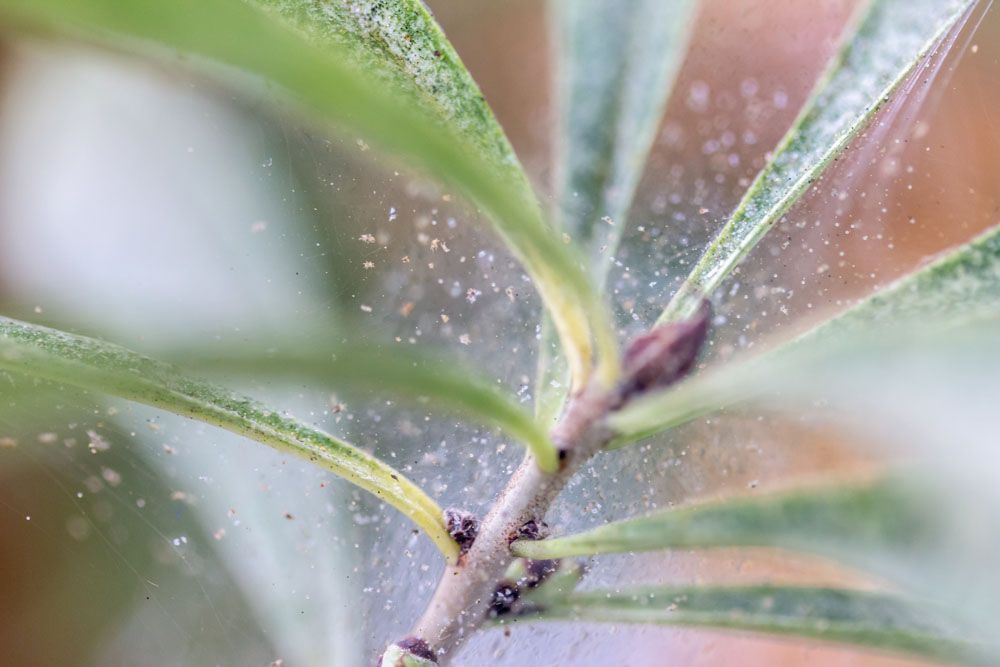
Spider Mites
Spider mites (Tetranychidae)
In North America, many species of the spider mite (family: Tetranychidae) attack both indoor and outdoor plants. Spider mites are classified as arachnid and are relatives to spiders, ticks, and scorpions. Adults are reddish-brown or light in color, oval-shaped, and extremely little (about the size of the period at the end of this sentence) (1/50 inch long). Spider mites thrive in hot, dry environments, mainly when their natural enemies have been eradicated by chemical usage. Plant-feeding mites, which make up the great majority, are preyed upon by various North American species.
The life cycle of spider mites:
The eggs of most mite species overwinter on the leaves and bark of their host plants. As the weather warms in early spring, tiny six-legged larvae hatch and feed for a few days before finding refuge and molting into the first nymphal stage. Nymphs have eight legs and go through two additional molts before they reach adulthood. Females can generate as many as 300 eggs in a few weeks after mating. Hot, dry conditions aid the fast development of these pests. In such circumstances, the transition from egg to adult might take as short as 5 days. Each year, numerous generations overlap.
Damages caused by spider mites:
Spider mites wreak havoc on plants by sucking the fluids out of them. Stippling appears on the leaves, and more severe damage can cause leaf bronzing, leading to leaf drop. Leaf drop raises the risk of sun/light burn and has a detrimental impact on the plant’s vegetative and blooming stages. Curled and scorched leaf margins and leaves with a leathery feel are other indicators of spider mites. When mite populations become large enough, the webbing will appear on leaves, twigs, and fruit/buds.
How to prevent an infestation:
- Ensure to inspect a fresh plant or one brought in from the outdoors before bringing it inside.
- Establish a regular check-up schedule (every 7-10 days).
- At least once every two weeks, wipe the tops and bottoms of the leaves and the stems using a damp paper towel. Weekly is preferable!
- Spider mites may be kept at bay by misting leaves often with water.
- Allowing your plant to get dehydrated is a bad idea.
- As a prophylactic step, use Neem Oil. Many hazardous insects and mites are repelled by it. The best time to use Neem Oil is during the spring and summer months.
- Once every two weeks, lightly spray the top and undersides of the leaves and the stems with Neem Oil.
How to get rid of spider mites:
To avoid an all-out infestation, which is more difficult to eradicate, it’s critical to spot spider mites on plants early on. People, pets, and plants are all safer when using organic ways. If you suspect that any of your plants have been harmed, follow these procedures. (For further information on how to recognize spider mites and the harm they inflict, see the section below.)
Spray with water:
To remove webbing and as many insects as possible, use a nozzle linked to a garden hose to provide a moderate water spray. Make sure to obtain the leaves’ undersides. This also eliminates dust from the leaves, which mites like to hide in.
Insecticidal soap should be used:
Allow the plants to dry before applying an insecticidal soap made from natural ingredients. Spray early in the morning or late at night. Avoid using when the temperature is above 90 degrees F. To interrupt the egg hatching cycle, reapply every 7-10 days or as the manufacturer directs.
Homemade remedies:
Insecticidal soap may be made at home—1 tablespoon Castile or Ivory liquid soap, dissolved in 1-quart water. Use a spray bottle to apply it. Garlic, pepper (capsaicin), peppermint, and rosemary are other natural medicines available.
Neem oil:
Neem oil, a natural product of the neem tree, is a universal insect repellent that suffocates spider mites when applied. This is a longer-lasting solution that is frequently used following an insecticidal soap application. Use only as instructed, and keep pets and children out of reach.
Other bugs can be utilized:
Natural pest management is provided by beneficial insects that feast on spider mites. Ladybugs, predatory mites, lacewings, and spider mite killers are among them. These insects do not harm people, pets, or plants. If you can acquire the friendly bugs as eggs, this technique is the most effective (adults will usually fly away).
Additional precautions:
Remove the most infected leaves, store them in a tight plastic bag, and throw them away if an infestation gets serious. Do not compost them, as this will spread the issue. An entire plant may need to be eliminated in severe circumstances.
Chemicals should be avoided:
Chemical pesticides have the potential to disrupt the ecological equilibrium. Other predatory pests may be able to migrate in. As a result, they were causing additional issues.
